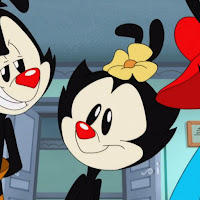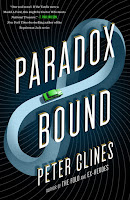A couple weeks ago I talked about a certain kind of opening that shows up in a lot of books and movies. It’s when that prologue or first chapter or first scene has some stuff happen (computer virus is stolen, monster lands on earth, vampire comes out of the earth, etc) and then it jumps forward in time four day, five weeks, six months, or more. It can be a problematic opening, and the fact that I feel the need to point out that time gap—how separated these events are—should usually be a sign to take a serious look at how important that opening chapter or scene really is.
Today I wanted to talk about the reverse of that opening. It’s another one you’re probably familiar with, and I’d guess it should probably be an even bigger red flag. It’s not always a sign I’m doing something wrong… but I think it’s really leaning that way.
What I’m talking about, of course, is the infamous opening scene of high action, desperate people, severe crisis, screams, shouts, gunfire, exclamations, and then—
Thirty Six Hours Earlier…
You’ve seen this, yes?
Now, on a casual first glance, this opening seems great, right? We’re diving right into the action at the start. We’ve got tension. Strong character moments. And then—usually—a following scene that shows these characters in very different circumstances, leaving us with the mystery of “how do they end up there?”
Thing is, the more we look at it, the more this opening tends to falls apart.
 First, it’s dropping us deep into the action. Sounds good on the surface, but as we’ve talked about before, a lot of folks who do this misunderstand what “starting with action” really means. By its very nature this opening is out of context, and there’s a good chance I don’t know any of the characters involved, so this “action” opening has superficial stakes at best.
First, it’s dropping us deep into the action. Sounds good on the surface, but as we’ve talked about before, a lot of folks who do this misunderstand what “starting with action” really means. By its very nature this opening is out of context, and there’s a good chance I don’t know any of the characters involved, so this “action” opening has superficial stakes at best.
Think about it. Me telling you Wakko has a knife to Dot’s throat is… bad? Good? Bad for Wakko? Without context, there’s a drastically different way to view almost any scene any of us can imagine. Seriously. Kids on the playground, people fooling around on the couch, someone reading a book in the library—in the right context, any one of these can be funny, sexy, sinister, or right out creepy.
Ah-hah! Says random internet guy #108. That’s the whole point! Like you said above, it’s creating a sense of mystery!
Funny you should mention that…
Second, this opening’s trying to build mystery by showing me an out of context piece of my story. But, a lot like the straight action, this opening mystery is a mystery without any stakes. If I need another six or seven scenes to establish “no, it’s really weird that Wakko would have Dot at knifepoint,” well… doesn’t needing another seven scenes to explain it kind of hint my opening isn’t that powerful?
Plus… this isn’t really a mystery. It’s just withheld information. We expect things are going to be different at the end of my story. The tension level should be higher. My characters should be in a different place, on several levels. It’s sort of like if I said “Wait, he’s Spider-Man at the end of the movie, but he’s just Miles Morales at the beginning?? Whoa! How could that possibly happen?”
The point of the story, quite literally, is to tell us how we get to the end of the story.
Third, it sucks a lot of tension out of my story. One way or another, I’m telling people who makes it to the end. Nothing that happens to Wakko until then is going to be a real threat, because I know he needs to be there at the end to hold a knife to Dot’s throat. Likewise, Dot’s got to be there to be knife-helden. Anyone standing around watching this? Well, we know they’re going to make it, too. This may sound silly, but if I tell people what happens at the end of my story… they’re going to know what happens at the end of my story.
Small note—if I’m gambling on my readers/audience forgetting that opening bit and being surprised when the plot guides us back to it, well… does that sound like a great opening? One I’m hoping my readers forget?
Fourth and finally, I think when I use this kind of beginning, it’s me admitting I just don’t have a great beginning for my story.
Y’know how I’ve suggested cutting off some prologues and seeing how the story works without them? I’d bet three out of four times, if I cut this “One Week Earlier” opening off my story, I’ll find the one I’m left with is kind of weak. Nothing really happens. The characters aren’t that interesting. It kind of meanders a bit before it gets back to the plot.
Y’see, Timmy, if I’ve started my story at the wrong point, the “Two Days Earlier” opening can seem like a quick fix. It’s me pasting on a more interesting beginning. But odds are it hits a lot of those problems I just mentioned. That’s why I think it’s such a big red flag.
I should consider starting my story now instead of at the end. I’m not saying this never, ever works, but if now feels like such a lousy place to start my story… well, that might be my subconscious telling me something.
And maybe I should listen to it.
Next time, I’d like to tell you why you should delete all your dating apps and meet someone the old fashioned way.
Oh! And a shameless self-plug. NPR is doing their summer reading lists and is looking for sci-fi and fantasy books that you loved from the past ten years. And while I’d never stoop so low as telling you how to vote on such a thing, I’m not above reminding you how much you liked Paradox Bound and how it’s a wonderful stand-alone novel that would appeal to most anyone. Just something to have in mind. While you vote.
Anyway, until next time, go write…



